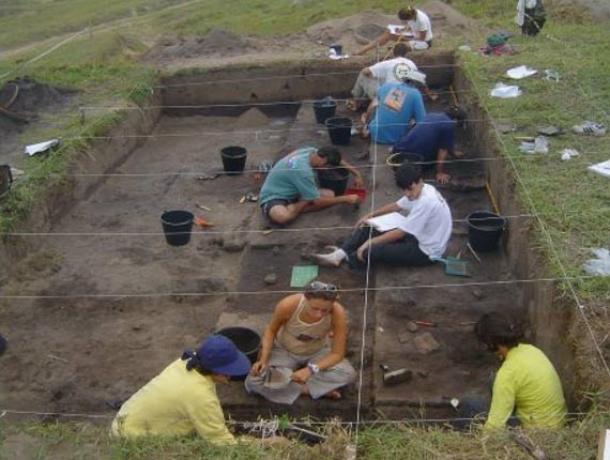🔴 Website 👉 https://u-s-news.com/
Telegram 👉 https://t.me/usnewscom_channel
A brilliant new study from Brazil has revised the historical narrative of human occupation along Brazil’s coast, offering new insights into the ancient sambaqui builders at the Galheta IV archaeological site in Laguna, Santa Catarina. The study offers new dating for the site, estimating it was active between 1,300 and 500 years ago, rather than the previously thought 1,170 to 900 years ago. Contrary to previous beliefs, the sambaqui builders at the Galheta IV archaeological site in Laguna, Santa Catarina, were not replaced by the ancestors of the Southern Jê.
The study has been published in PLoS ONE by researchers from the University of São Paulo’s Museum of Archaeology and Ethnology (MAE-USP), supported by The São Paulo Research Foundation (FAPESP). The research has been conducted in collaboration with scientists from the United States, Belgium, France, and various Brazilian states.
Researchers from MAE-USP and GRUPEP-UNISUL excavating the Galheta IV site in 2006 (Paulo DeBlasis/FAPESP)
Sambaquis: Shell Middens Pointing Towards Long-Term Human Occupation
Sambaquis, or shell middens, are ancient mounds made up of layers of shellfish debris, human and animal bones, plant remains, and various artifacts. These structures provide evidence of long-term human occupation and were used for burial, shelter, and territorial demarcation. Previously, it was believed that the builders of these mounds, the sambaquieiros, were replaced by the Southern Jê ancestors. The new findings have challenged this assumption.
“There was far less interaction than has been thought between these midden builders [sambaquieiros] and the proto-Jê populations, as we call them. Their funerary practices and pottery were different. Moreover, the sambaquieiros lived there from birth and were descendants of people who had lived in the same place,” says André Strauss, a professor at MAE-USP and penultimate author of the article, in a press statement.
This new perspective emerged from an extensive analysis of archaeological evidence, including materials re-examined from collections made between 2005 and 2007. Jéssica Mendes Cardoso, the study’s lead author, conducted isotopic analysis of strontium, carbon, and nitrogen in human remains, revealing that fish and other seafood made up 60% of the group’s diet. The analysis also showed that these individuals were not cremated, a practice typical among Southern proto-Jê populations.
One of the burial units found by the MAE-USP team in 2005; the material has now been re-analyzed using novel techniques (Paulo DeBlasis/PLoS ONE)
The Galheta IV site has provided unique insights into ancient coastal inhabitants, including faunal remains such as bones of marine birds like albatrosses and penguins, and mammals such as fur seals.
“These animals were not part of their daily diet but were consumed seasonally while they were migrating or might have been kept at the site. They were probably part of their funeral rites since no one lived in this place. The site was a burial ground,” Cardoso says.
There were 12 albatrosses in one burial unit, for example.
Jéssica Cardoso analyzing remains of animals found at the Galheta IV archeological site (personal archive/FAPESP)
Change in Settlement Patterns: Lessons from Material Culture
The new dating and timeline studied in conjunction with the analysis of pottery found at the site suggests that proto-Jê influence was more about cultural exchange than population replacement. Out of 190 potsherds excavated, 131 were large enough for detailed examination. The pottery’s design differed significantly from that of the upland proto-Jê but was similar to other coastal sites, indicating coastal cultural diffusion.
“The pottery is very different from that found in the Santa Catarina uplands, in terms of shape and decoration, but similar to that found at other sites on the coast in both the north and south of the state, showing that these objects may well have been transported from one coastal location to another. These are the oldest pottery remains found in the state, dating from 1,300 years ago, whereas the pottery found in the uplands is about 1,000 years old,” says Fabiana Merencio, second author of the article.
This suggests that changes in material culture and settlement patterns were likely due to environmental and cultural factors, such as changing sea levels and interactions with other groups, rather than a complete population replacement, reports Archaeology Mag.
The theory that one ethnic group replaced another arose partly because sites like Galheta IV mark the end of sambaqui building. The potsherds found in the most recent layers of mounds at these sites resemble the pottery of the ancestors of the Southern Jê Indigenous groups, such as the Kaingang and Laklãnõ-Xokleng. This resemblance supported the long-held belief that the sambaqui builders who lived on the coast were replaced by people from the Santa Catarina uplands.
“We don’t know why sambaqui building stopped. Possible explanations include contact with other cultures and environmental factors such as changing sea levels and salinity, which may have led to a fall in the supply of shellfish and hence of the raw material for shell mounds,” says Jéssica Mendes Cardoso, first author of the article.
Looking ahead, a new research group led by Ximena Villagran, a professor at MAE-USP, plans to explore another site, Jabuticabeira II, to further investigate these historical dynamics.
“We reveal a new expression of human materiality on the coast, some 1,000 years ago, in the shape of substitution for sambaquis of sites without mollusk shells but with pottery. This site is a Rosetta Stone that helps us understand these connections,” Strauss concludes.
Top image: A sambaqui on the coast of Santa Catarina: these mounds of shellfish debris, bones and other remains were burial sites. Source: Jéssica M. Cardoso/Plos ONE
By Sahir Pandey



